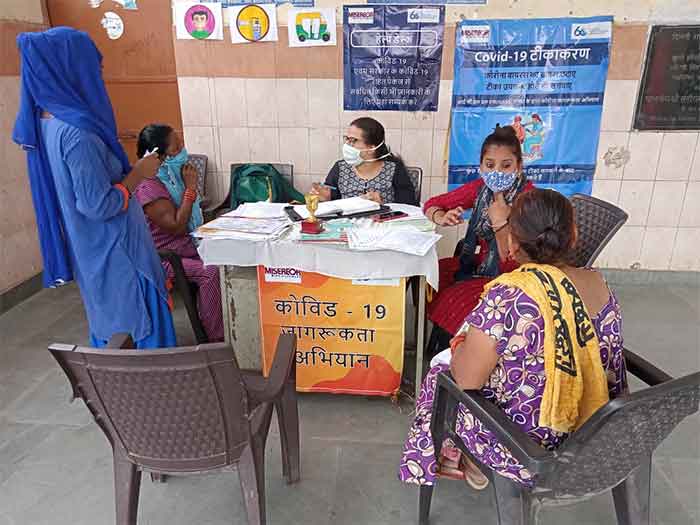
In a patriarchal society male privilege is not far away. So it should be no surprise that it has entered the domain of Covid vaccinations in India , especially at a time of vaccine shortage. Since the beginning of the vaccination drive, 14.99 crore doses have been administered to women while 17.8 crore doses have been given to men, government data reveals.(as on 30th Jun, 2021). That is to say 17 percent more men have been vaccinated so far than women. Of the 729 districts for which data is available, more men have been vaccinated in as many as 620 districts. Across 16 states and union territories, including some of the most populated like Uttar Pradesh, Bihar and even Delhi, women have not outnumbered men.Dr V.K.Paul of the Niti Ayog who is part of the high powered government panel that advises the government on its Covid response has acknowledged the gender gap but has not offered any solution to overcome the gap.
Vaccine hesitancy is one of the many reasons women are being left behind in India’s inoculation drive, which has so far fully vaccinated less than 4 percent of its adult population since it began in January. On the ground, many reasons are provided. Men are the ones who go out to work and therefore more at risk of running into Covid infected people either during the commute or during work.
Women are involved with household chores and hardly go out , so their danger of getting Covid is negligible. Then there are practical considerations. There is the mobility question. Vaccination centres are usually not near by and women are not independently mobile , possibly not even in cities and towns and definitely not in rural India. While initiatives like centralised registration and immediate generation of the vaccination certificate are in principle good and helpful, one size fits all type policies will rarely work in India. Policy makers may be well intentioned as they draft them but they are also blinded on multiple fronts.
One of those is gender blindness. Let me illustrate with an example. I remember going to visit a telemedicine initiative some years ago. This was at a time when mobile phones were not so ubiquitous and started at the behest of a charitable hospital which felt that enough women were not availing of their services as the hospital was at a distance to most of the women and they had no access to transportation. But the telemedicine somehow did not take off. As an outsider it did not take too long to figure out the reason. The hospital had purchased a few mobile handsets( they were still expensive then) and then placed with local shopkeepers who would allow the patient to call and connect with the doctor.
But the shopkeepers were all men and their shopfronts were often places where men hung out to gossip. It was not easy for women to step out in socially conservative UP and much less to a place frequented by sundry men. As for talking to a doctor about her private symptoms with folk listening in, it was an impossible ask. No wonder that hardly any women came and used the facility !
The roles that society has prescribed for men and women are largely responsible for the gender blind policies that we have which often unwittingly end up favouring men. Vaccination centres are usually in health centres or schools which are not necessarily near by. If vaccination centres were set up in Anganwadis which are more women friendly and staffed by a nurse assisted by an Anganwadi worker who are all women, would more numbers of women have got vaccinated ? Possibly yes. Could ASHA workers and ANMs, ubiquitous and trusted figures in rural India have been roped in as mobilisers ? Again yes. Election commission mandates in India require that no elector should have to travel more than 1.24 miles to cast a vote and this has often required polling agents to travel vast distances to enable a few people to cast their votes. Could this rule have been invoked here ? Perhaps. In the days before Polio was eradicated in India ( and even now on the Pulse Polio days), it pretty much impossible to step out of the house and not encounter a volunteer ready to administer Polio drops to all those below 5 years. Of course, undoubtedly the fact that Polio was orally administered made a difference but even there, rumours abounded about the side effects of the vaccine which had to be gently countered.
The case is not that all the examples and possibilities cited can be be necessarily implemented in exactly this way. What is being cited though is that in a country of India’s diversity , a “one size fits all” policy has never worked for anything. Getting more women vaccinated and closing the gap will mean not just dealing with infrastructural bottlenecks but also motivational challenges. Misplaced beliefs in India have led to narratives of misinformation, disinformation and misplaced beliefs have led to fears about potential hazards of the vaccines. Wider consultations with entities actually present on the ground , be it government entities like panchayats or local civil society and religious institutions – ideally all would possibly have yield locally workable solutions to draw more women into the vaccination net, especially so in a time of shortages where those feeling entitled will make deliberate efforts to keep others out.
Dr Shantanu Dutta , a former Air Force doctor is now serving in the NGO sector for the last few decades.













































